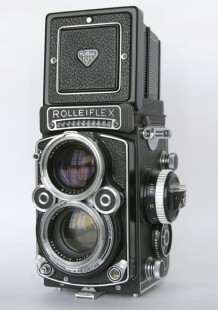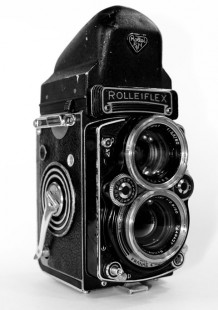My eye was caught by the item kindly sent in by John Gregory and reproduced in the October 2012 issue of Club Rollei User. It is an advertisement placed by Alec Pearlman in Amateur Photographer in April 1961. The print was rather small so many may have missed the detail but his sales message was:
‘The Last Gimmick Free Rollei 2.8 for the Expert or Professional'
Like many other modern cameras, the famous Rolleiflex has ‘gone automatic’ with coupled exposure meters, coupled irises and what-have-you, but the basic camera required by the professional or serious amateur continues to be a comparatively simple instrument with no frills.’
Pearlman then lists the various 2.8E2 models he could supply, both with and without built-in exposure meter. As John says, he sounds a bit testy about the so-called automatic functions (represented by the 2.8F although not mentioned by name in the advert).
No doubt many readers (as myself) will have used a 2.8F or a 3.5F over the years and have their own opinions about the camera’s attractiveness, but suffice to say they sold in good numbers when manufactured new and continue to attract good prices in the secondhand market. However, if anyone who has never used one of these cameras reads Pearlman’s comments, they could easily be put off buying one.
Would that be justified?
In my view, that is doubtful.
The main difference between the 2.8E2 and the 2.8F is that the latter is provided with an exposure meter coupled to the aperture and shutter speed controls, whereas the former has an option of a non-coupled meter or no meter at all. In actual use, the meter in the 2.8F can be referred to or completely ignored at the user’s discretion and as it is solar-powered there is no battery to worry about. The user retains total control, unlike with truly automated cameras such as the Rolleimagic I. For myself, I find that in good lighting (e.g. outdoors in sunlight) the exposure is best estimated based on personal knowledge and experience, but in low light the meter comes in extremely handy – and is accurate. For the purpose of correctly exposing colour reversal film, it would be very difficult to work without it in unfavourable light, although arguments exist for and against using a hand-held meter instead. The 2.8E2 meter I find nowhere near as good, what with the changeover switch between high and low light and the need to obtain a reading as an Exposure Value then transfer that reading from the meter to the aperture and shutter controls.
So what then is/was the objection to the 2.8F? Well, clearly an E2 without meter was slightly cheaper but not vastly so. The absence of a meter means that the camera is less vulnerable to damage because the plastic cover over the meter needle is unquestionably the most breakable component. The meter coupling undoubtedly complicates the internal mechanism of the 2.8F/3.5F and that means repairs to these cameras tend to cost more than to simpler Rolleis. However, with a great many 2.8Fs and 3.5Fs which may be over 50 years old, still working well and being repaired when necessary they cannot be seen as a major drawback.
For myself, I have a 2.8F, a 2.8E2 with meter and a 2.8E3 without meter so can choose freely between the options. Suffice to say the 2.8F sees use most weeks whereas the other two would be lucky to be used a couple of times a year (admittedly partly in the case of the 2.8E2 because the taking lens in mine is noticeably less sharp at the larger apertures).
I can only assume that Pearlman had quite a few 2.8E2s in stock and was anxious to make some sales, which might have been difficult with the more advanced 2.8F having been introduced. Certainly this seems borne out by the experience of the 2.8E3, which was supposedly brought out in response to demands for a simpler f2.8 TLR after the 2.8E2 had been discontinued, but achieved disappointingly small sales.
In short, if you fancy a 2.8F and find one in nice condition, do not be deterred from buying it!

